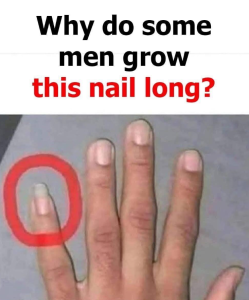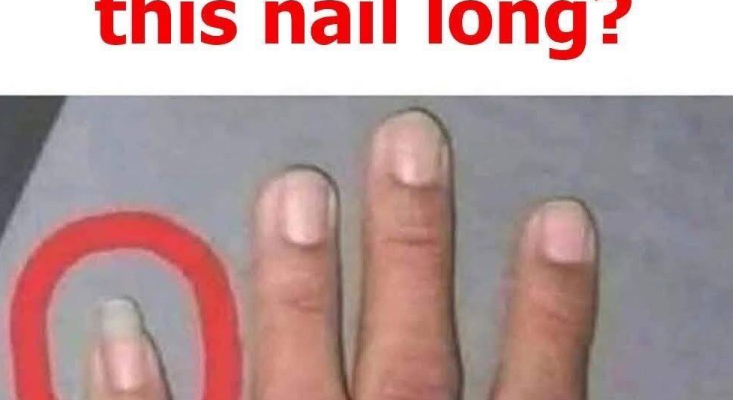The Long Pinky Nail: A Tiny Detail with Monumental Meaning
At first glance, a long pinky nail might seem like a quirky fashion choice or a grooming oversight. But look closer, and you’ll find a surprisingly rich tapestry of cultural, social, and practical significance woven into this small, often overlooked detail. From ancient dynasties to modern subcultures, the long pinky nail has served as a symbol of status, a tool of utility, a badge of rebellion, and even a quiet act of advocacy.
🌏 Cultural Origins: Status, Class, and Power
Historically, long nails—especially the pinky—have been potent symbols of wealth and privilege. In ancient China, aristocrats and scholars grew their nails long to signal that they didn’t engage in manual labor. The longer the nail, the clearer the message: “I am above physical toil.” This tradition was so entrenched that some elites wore ornate nail guards to protect their elongated nails, turning them into literal status accessories.
In India, similar associations emerged. A long pinky nail among men was often seen as a marker of higher social standing, a subtle way to distinguish oneself from the working class. In Turkey, the long pinky nail took on a more utilitarian role—used by men to open cigarette wrappers, blending practicality with cultural habit.
Even today, in parts of Asia, a long pinky nail is considered lucky. It’s believed to attract positive energy and prosperity, especially if it extends past the joint nearest the fingertip. In this context, the nail becomes a talisman—small, silent, but powerful.
🎭 Social Signals: Rebellion, Identity, and Awareness
Beyond tradition, the long pinky nail has evolved into a social statement. In some circles, it’s associated with rebellion and counterculture. During the 1970s and 80s, the “coke nail” stereotype emerged—referring to individuals who used their long pinky nail to snort cocaine. While this association is largely negative and rooted in illicit behavior, it reflects how a simple grooming choice can become a loaded symbol.
But not all social meanings are shadowed by controversy. In recent years, the long pinky nail has been reclaimed as a tool for advocacy and awareness. Campaigns like Polished Man and Pinky Promise encourage people to paint or grow a single nail—often the pinky—to raise awareness about violence against women and children. In this context, the nail becomes a quiet protest, a conversation starter, and a symbol of solidarity.
For some, especially within LGBTQ+ communities, the long pinky nail can also serve as a subtle marker of identity—an aesthetic choice that signals belonging, creativity, or defiance against normative beauty standards.
🛠️ Practical Purposes: Art, Music, and Everyday Utility
Not all long pinky nails are symbolic. For many, they’re simply useful.
- Artists sometimes grow their pinky nails to steady their hands while painting intricate details. The nail acts as a brace, allowing precision without smudging the canvas.
- Musicians, particularly guitarists, may use a long pinky nail on their strumming hand to create unique sounds or aid in fingerpicking techniques.
- In everyday life, a long pinky nail can be surprisingly handy—used to peel labels, tighten small screws, cut soft items like fruit, or even scratch an itch in a hard-to-reach spot.
These practical uses strip away the mystique and reveal the nail as a functional tool—one that’s shaped by personal needs rather than cultural expectations.
🧠 Psychological and Symbolic Layers
There’s also a psychological dimension to the long pinky nail. In palmistry and hand analysis, the pinky finger is associated with communication, intuition, and persuasion. A long nail on this finger might be interpreted as a sign of someone who values expression, detail, or control.
In some spiritual traditions, nails are seen as extensions of the body’s energy. Maintaining a long pinky nail could be viewed as a way to channel or preserve certain energies—though this belief varies widely across cultures and is often more metaphorical than literal.
👀 Misconceptions and Stereotypes
Despite its rich history, the long pinky nail is not immune to misunderstanding. The “coke nail” stereotype still lingers, especially in Western media, casting suspicion on individuals who wear one. This reductive view ignores the nail’s broader significance and unfairly stigmatizes a practice that may be rooted in culture, art, or advocacy.
Similarly, some people assume that a long pinky nail is purely aesthetic—an attempt to stand out or follow a trend. While that may be true for some, it overlooks the deeper motivations that often drive this choice.
🔄 Modern Revival: TikTok, Fashion, and Personal Expression
In the age of social media, the long pinky nail has found new life. On platforms like TikTok, users share videos explaining their reasons for growing or painting a single nail—ranging from cultural pride to artistic technique to social activism. The nail becomes a micro-story, a visual cue that invites curiosity and conversation.
Fashion designers and influencers have also embraced the look, incorporating long pinky nails into editorial shoots and runway shows. In this context, the nail is both accessory and attitude—a small detail that adds edge, elegance, or eccentricity.
💬 Final Thoughts: A Nail That Speaks Volumes
So, what does a long pinky nail really mean?
It means status, if you’re looking through the lens of history. It means utility, if you’re an artist, musician, or DIY enthusiast. It means identity, if you’re expressing your place in a community or movement. It means advocacy, if you’re raising awareness for a cause. And sometimes, it just means you like how it looks.
In a world obsessed with big gestures and loud statements, the long pinky nail is a quiet rebellion—a subtle, elegant, and sometimes provocative way to say something without saying a word. Whether worn for tradition, function, or flair, it’s a reminder that even the smallest details can carry the weight of history, culture, and personal truth.


